Korean Box Office: July 13-15
16th July 2012
Posted in Uncategorized | Comments Off

15th July 2012
There are five Korean movies being released on DVD this week. Let’s start with the biggest…’biggest’ as in size of release and what will probably be the biggest seller, My Way.
My Way stars popular actor Jang Dong-geun along with Japanese actor Joe Odigiri and it is directed by Kang Je-gyu. Considering the budget spent on the film, it did not do as well as expected in the box office, attracting just over 2 million viewers. However, Jang is a popular actor throughout Asia and the movie is likely to be popular among his fan base. Number of discs: 3/ Subtitles: Korean and English/ Rating: for ages 15+/ Format: 2.35:1 anamorphic widescreen/ Audio: Dolby Digital 5.1/ Running Time: 135 minutes/ Suggested Retail Price: 27,500 KRW/ Available for purchase: July 20th.

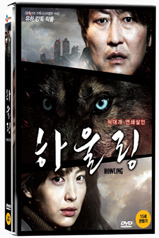 Pictured on the left is the DVD for the thriller Howling. It was directed by Yoo Ha and stars two familiar faces, Song Kang-ho and Lee Na-yeong. About 1.5 million people saw it in the theater at the time of its release. Number of discs: 1/ Subtitles: Korean and English/ Rating: for ages 15+/ Format: 2.35:1 anamorphic widescreen/ Audio: Dolby Digital 5.1/ Running Time: 114 minutes/ Suggested Retail Price: 23,500 KRW/ Available for Purchase: July 16th.
Pictured on the left is the DVD for the thriller Howling. It was directed by Yoo Ha and stars two familiar faces, Song Kang-ho and Lee Na-yeong. About 1.5 million people saw it in the theater at the time of its release. Number of discs: 1/ Subtitles: Korean and English/ Rating: for ages 15+/ Format: 2.35:1 anamorphic widescreen/ Audio: Dolby Digital 5.1/ Running Time: 114 minutes/ Suggested Retail Price: 23,500 KRW/ Available for Purchase: July 16th.
The next movie is Wido, a mystery starring Jeong Chan and Lee Doo-il. It was directed by Kim Gwan-cheol. The title of the film come from the name of an island here in North Jeolla Province. The movie had a very limited release –only five screens nationwide (which in my case, adds to the appeal when deciding whether to purchase it or not). Number of discs: 1/ Subtitles: Korean only/ Rating: for mature viewers/ Format: 16:9 anamorphic widescreen/ Audio: Dolby Digital 2.0/ Running Time: 106 minutes/ Suggested Retail Price: 25,300 KRW/ Available for purchase: July 17th.
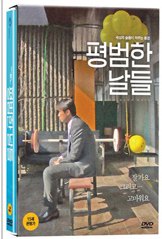
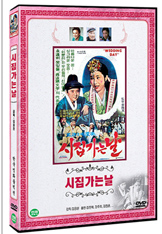 Ordinary Days (image left) is an omnibus film directed by Lee Nan and starring Song Sae-byeok and Han Hye-ri. Like the above film, this movie had a very limited release and six of the ten screens it was released on were in Seoul, so most of us have not had the opportunity to see it yet. Number of discs: 1/ Subtitles: Korean and English/ Rating: for ages 15+/ Format: 1.85:1 anamorphic widescreen/ Audio: Dolby Digital 5.1/ Running Time:106 minutes/ Suggested Retail Price: 25,300 KRW/ Available for Purchase: July 17th.
Ordinary Days (image left) is an omnibus film directed by Lee Nan and starring Song Sae-byeok and Han Hye-ri. Like the above film, this movie had a very limited release and six of the ten screens it was released on were in Seoul, so most of us have not had the opportunity to see it yet. Number of discs: 1/ Subtitles: Korean and English/ Rating: for ages 15+/ Format: 1.85:1 anamorphic widescreen/ Audio: Dolby Digital 5.1/ Running Time:106 minutes/ Suggested Retail Price: 25,300 KRW/ Available for Purchase: July 17th.
If someone were to tell me that I was limited to buy only one film of the five listed here, it would be this final film, Wedding Day. When I first saw the Korean title, I was disappointed because I have a KOFA release of a DVD with the same title and I wondered why the Korean Masterpiece Collection would choose a film to release that was already available. But then I noticed the director and I realized that this is the 1977 version of the film– the previous release was from 1955. I will certainly be buying this and wonder how the two films compare. Number of discs: 1/ Subtitles: None/ Rating: for all ages/ Format: 4:3 full screen/ Audio: Dolby Digital 2.0 mono/ Running Time: 98 minutes/ Suggeste Retail Price: 16,500 KRW/ Available for Purchase: July 19th.
Posted in DVDs: New Releases | Comments Off
14th July 2012
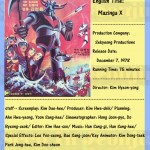 This week I am listing two directors here as neither made many films during the 1970s. The first is Kim Hyeon-yong who made exactly one film in his life–an animation that copies the Japanese character Mazinger Z far more than it should have and made no effort to hide it. Meet Mazinga X! As always, click the thumbnail to view the full-sized image… and you can access the films of other directors from this decade by clicking the tab marked ‘The 1970s’ at the top of this page.
This week I am listing two directors here as neither made many films during the 1970s. The first is Kim Hyeon-yong who made exactly one film in his life–an animation that copies the Japanese character Mazinger Z far more than it should have and made no effort to hide it. Meet Mazinga X! As always, click the thumbnail to view the full-sized image… and you can access the films of other directors from this decade by clicking the tab marked ‘The 1970s’ at the top of this page.
The other director whose films I have included today is Kim Hyeong-joon. He was involved in the making of several co-productions with Hong Kong filmmakers. The movie I have listed here as Magnificent Fist can be found on the KMDb under the title The Fighter with Miraculous Martial Arts. I did not change the title on a whim because the latter is unwieldly. Instead I chose the shorter English title as that is what the movie was released under in Hong Kong in 1979.
Posted in K-Movie Index | Comments Off
12th July 2012
The end of the 70s was an unusual, and frustrating, period of Korean film history. On the one hand you had people like Kim Ki-yeong with movies like Iodo and Neumi, pushing the envelope with experimental imagery but his commendable frankness about sex is starting to slip into near-exploitation– a fault suffered by many films of many director the 1980s. And then you have films like this which falls back on the tried, true and safe formulas of the late 60s and early 70s. On the surface, through its title and its title, The Woman Who Leaves Work in the Morning seemed like it might have fallen into the former grouping, trying to sell the film by making it appear far more sensual than it actually is– another trend of the 80s, especially when covers were shot for the VHS markets. This movie debut work of director Park Yong-joon who would continue to direct films until 2001 when he directed the direct to video Game Over and draws from more famous movies–or perhaps their source materials– of the past, particularly I Hate You Once Again and a little bit of Heavenly Homecoming of the Stars. Two of the good things about this film are Ko Doo-shim in her first role and Ha Myeong-jong showing why he could easily be thought of as the Shin Sung-il of the 70s. I did not mind watching the film for these two and the story did have some interesting moments but for the most part, it was very familar.
Jang Soo-mi (or Jang-Mi–meanng Rose–for short) is a hostess in a bar, meaning that she sits with the male customers, pours drinks and flirts with them to ensure they keep coming back. One morning, while walking home, she encounters a young photographer and is smitten by his good looks and charm. They meet only a couple of times before the artist, Song Woo-yeol, simply moves into the small apartment that Jang Mi shares with her younger sister Yeong-ah. The elder sister is clearly in love although the two have no commitment to each other at this point, and she resents that Yeong-ah and Woo-yeol are growing quite close. It is quite innocent on the part of Yeong-ah who, although having graduated from high school, is not yet out of her teens but Woo-yeol is something of a ladies’s man and it is hard to believe his protestations of innocence–especially after Jang-mi walks in on the pair kissing. She knows that Woo-yeol cannot be in the same house as her sister, so Jang-mi makes a choice– and kicks Yeong-ah out of the apartment!
I wish, and fully expected, that more time would be spent on Yeong-ah after leaving the house. How did she live? Was she resentful? What happened to the relationship between the two sisters. But no. The film glosses it over. Yeong-ah admits her mistake, packs her bags, and leaves not appearing again. Nor does Jang-mi bring her up in one of her moments of guilt or self-pity that she regularly has bouts of. Instead, she and Woo-yeol become lovers. They both continue with their work and lives while living blissfully together.
However, this bliss does not last. Woo-yeol returns home to visit his father who tells him that he must marry soon. The young photographer becomes engaged to a woman in his own economic class which, as it turns out, is considerably higher than how he presented himself. His status all but ensures that he could never realistically marry a hostess. After calling his home to find out when he will be returning, Jang-mi learns that Woo-yeol has another girlfriend. At first infuriated, Jang-mi soon calms down after talking with Woo-yeol. He promises to come to see her the following day, which is her birthday, instead of telling her the truth, that he will be married in two days. After she prepares her own birthday dinner and waits up for him all night, Woo-yeol finally gets around to telephoning and explaining that he could not come because he was planning his wedding. Once again mad with rage, Jang-mi drives to the wedding site, half-intending to kill her lover for his betrayal, but becomes frozen after getting his attention after the ceremony. Not only does she not attempt to kill him, she does not even tell him that she is pregnant.
The movie then jumps ahead approximately 6 or 7 years and the story of I Hate You Once Again starts and continues for the last 30 minutes or so of the film. Anyone familar with that classic story knows that the single mother in that story gives up her child to the father so the youngster can be raised in luxery, only for the child to be miserable for missing his real mother.
The movie ends on a note that should be somewhat happy, but somehow just seems to sudden and incomplete and while it was clearly tries to dredge up feelings of nostalgia for one’s mother, it fails miserably in doing so. I blame the child actor… he was quite bad, often looking at someone off camera and being very unconvincing in his rapid mood swings. While not a terrible movie, it is perhaps a little too typical of early-70s film-making in Korea. If you have not seen many films from that period, you may find it interesting. But the fact that it comes after that period had already passed made the viewing experience seem a little out of date and if you are familar with 70s films, you can probably skip this one as it offers nothing new.
Posted in 1970s | Comments Off
11th July 2012
Continuing with my project of retyping the issues of Korea’s first English-language newspaper, The Independent, this week features the next edition, vol. 1 no. 37 from Saturday, June 30th, 1896. <<REMINDER: The opinions expressed in The Independent DO NOT represent my views and are merely presented here for historical context.–tom>> In this issue: The editor worries that cholera is on its way again due to unsanitary conditions, the police of Seoul are rejecting their western style clothes in favor of their traditional looks, the poplation of Seoul was counted, and an incident of stupidity on the part of a thief.
Editorial
It is not improbable that the cholera may visit the city of Seoul again this summer. To be sure the severe epidemic of chlera in 1886 was not followed by another in 1887, but of course, the inherent probability was greater than if there had been none the preceding year. A few sporadic cases have made their appearance which, though not cholera proper perhaps, show marked similarity to that dreaded disease. If anything is to be done to fight it this year, a beginning must be made immediately, if indeed it is not already too late.
It is such a simple thing to say, “keep the sewers open and clean, prevent the accumulation of garbage, look out for contamination of wells, make people drink boiled water and stop their washing vegetables in the gutters,” but the carrying out of these simple directions means a revolution in Korean methods of life and in their time-honored customs. If my father washed his cabbage in this ditch, it is good enough for me to wash mine in.
The Koreans have a proverb which says; “In trying to take a short cut across lots he fell in with thieves,” which means that the man who goes around by the old time-honored road will do better than the one who tries some new-fangled method. There is a ponderous inertia in these Eastern people, and a stolid indifference to the channels through which disease is contracted, however much they dread the disease itself. It amounts almost to fatalism. A few object lessons on Korean well water through a compound microscope would open their eyes.
It is of no avail to talk about what might be under different circumstances, but we must ask the question, what can now be done, taking all obstacles into consideration, to prevent the coming of cholera or check its spread if it does come.
In the first place a sum of money must be appropriated, commensurate with the work to be done. It must be put in the hands of some man who will dispense it judiciously and honestly. The government should set all the city convicts at work cleaning up the streets. The police should watch the wells and see that refuse is not allowed to lie around them. If possible it would be an excellent plan to have each of the main wells put in charge of a competent man and have him see to it that only proper vessels are used in drawing the water; of better still, a man should be stationed at each well, whose business it should be to draw water for all comers, but money must be forthcoming to pay them. This would take a comparatively small sum and wuld be one of the very best preventatives, for there is probably nothing that tends to spread disease more than this prmiscuous use of wells, each person using his own utensils for drawing the water. Besides this, the bringing into the city of green fruit such as apricots, melons, peaches and the like should be prohibited. It would entail some hardship on the people but better that tan a summer like last.
We look for something to tbe done immediately by those in authority and upon them will the balme fall if the epidemic comes and finds the city wholly unprepared.
Brief Notice
The June number of the Korean Repository appeared Wednesday. It gives us its usual varied contents, interesting to all kinds and conditions of people, all the way from philological discussions to town gossip. Rev. GH Jones gives us a clear and concise exposition of the status of women in Korea, which shows clearly that the ‘new woman’ form of inebriety has not yet reached Korea. Dr. Edkins gives another talk on affinities of the Korean language, a sort of philological tight rope walk in which few can follow him. Mr Hulbert talks about the origin of the alphabet, adducing some evidence in support of its Thibetan origin. Mr. Appenzeller gives an interesting account of a visit to Pyeng Yang and the battle-field and Dr. Wells tells us of some of his medical impressions. The editorial, literary and miscellaneous departments are filled with timely and interesting material. On the whole our monthly contemporary is sustaining its customary high level.
The new Chief of Police does not wear his official uniform, and still wears his top-knot. His subordiantes are gradually following the example of their Chief and there are a number of new top-knots being raised among the Police force. If the Chief does not change his mind, we will soon see every police officer regaining his top-knot and probably the unifrom will be shelved. Even now, we notice the army and police officers are not proud of their uniforms and helmets, as is the case with the officers of other countries. It is largely due to the discouragements they meet from their superiors.
The Governor of Tong Nai and Tai Ku reports that the Government troops routed the insurgents in Kyeng Ju district.
The Magistrate of Po Chun reports that 300 insurgents entered the town of Kai Pyeng on the 23rd.
The Governor of Tai Ku reports that the Tai Ku troops encountered a band of insurgents a few days ago and firing bgan on both sides, but the insurgents were on the higher ground so the Tai Ku troops made a retreat. The insurgents followed them down to the lower ground where the Tai Ku troops turned and made a sudden assault upon them and routed them completely.
The Governor of Kong Ju reports that two leaders of the insurgents in Chen Chun and Mok Chun districts have been caught be the Seoul troops and were beheaded on the 22nd.
According to the latest census taken by the Police Department, the population of Seoul and the immediate vicinity (the river towns are excepted) is 179,702 and the number of houses 37,737. The population inside of the wall 117,915, and the number of houses is 22,974. This does not include foreign residents.
A thief wrote a letter to Yi Sun So of Kat-Chun-Kol saying that he needed 10,000 cash and must get it from somebody. He asks Yi to place the sum under the stone bridge across the street at 2 o’clock in the morning when he wil come and get it. He further states that if Yi should not obey the order, Yi’s house will be burned the next night, and if Yi should tell this to anyone he will kill Yi in a few days. Yi placed the money in the place named and gave the letter to the police. At 2 o’clock next morning the police were watching for the thief near the bridge, and as he came up punctually they captured him at that hour. He was very much surprised when told that he was under arrest.
Mr. Hara, the new Japanese Minister is a native of Iwata Prefecture. In 1876, he entered the Law School which was then attached to the Judicial Department, but did not complete his studies. He took to journalism, but later joined the Foreign Department and was sent to Tientsin as Consul. Subsequently he became Director of the Commercial Bureau in the Foreign Department, which appointment he held until he succeeded Baron Hayashi as Vice Minister for Foreign Affairs, when the latter gentleman was appointed Minister to Peking.
The Russians at Peking are buying large lots of Chinese books for the use of their countrymen who may wish to learn the Chinese language and literature. It is said Chinese Schools will be established in various parts of Rusia, and that some Chinese teachers have actually been engaged.
Last Friday, the Seoul Chamber of Commerce had a mass meeting and discussed the feasibility of encouraging Commerce, and other topics relating to the improvement of general traffic. The Ministers of Finance, and Commerce and other prominent officials were present and took part in the discussion. It is commendable on the part of these high officials to meet together with the businessmen of the city and explain the importance of commercial aggrandisement for the country’s good. March on, everybody!
The Capitalists of Seoul are perfecting the scheme of a banking organization in the city. They expect to secure $200,000 of capital by shares. They will issue 400 shares at $50 each and so far they have recieved already enough subscribers to cover more than half the capital. They will open the bank in one of the brick houses in the business block belonging to the Seoul Improvement Company, Chong Dong. The institution will be managed by a cometent foreigner whose business sagacity and intergity is beyond question. We will keep the public informed of the details fo the laudable enterprise.
A well-dressed woman, about 70 years old, while walking along on the street near Chong No, lost consciousness suddenly and fell on the curb stone. The police carried her to the station where she recovered her senses and asked the police to take her to her home in Chung Pai, outside the South Gate. She was taken there in a chair.
Major Jang Ki Ryem, while marching with his battalion to Won Ju, met a band of insurgents who occupieda village in Won Ju and routed them. After the fight, some of the Seoul soldiers entered the houses of the citizens and took away some articles. The Major immediately siezed the culprits and shot them on the spot. The War Office commended his action and the people in that disctrict praised the Major’s exemplary discipline among his troops.
The Governor of Seoul issued an order saying that after repairs of the streets in Seoul, whoever throws garbage or any other filthy substance on the street will be punished severely. We are in hearty sympathy with you, Mr. Governor.
Posted in The Independent: 1896 | Comments Off
10th July 2012
This week we have no less than twenty new movies opening across Korea this coming weekend. Five of them are Korean and their trailers are below. Films from other nations are as follows: Cat Run (us), Everything Must Go (us), Days of Darkness (us), Limitless (us), Pool Boys (us), Anything for Her (fr), In Gold We Trust (fr), The Best Exotic Marigold Hotel (uk), Street Dancer 2 (uk), Artic Blast (au), Lost in Beijing (ch), Soft Boys (jp), People of Baekja (jp), Wandering Home (jp) and Fake Sisters (jp).
The first trailer here is for the new horror film Two Moons, directed by Kim Dong-bin and starring Park Han-byeol and Kim Ji-seok.
Next we have a thriller entitled Venus in Furs starring Seo Jeong and Baek Hyeon-jin and directed by Song Ye-seob.
Dangerously Excited is a comedy directed by Ku Ja-hong and starring Yoon Je-moon and Song Ha-yoon.
I love the 70s retro title of Bloody Fight in Iron Rock Valley which matches the setting of the film and the old Hong Kong action movies it was inspired by. It was directed by Ji Ha-jin and stars Lee Moo-saeng and Yoon Sang-hwa.
The above film was only one of two that Lee Moo-saeng is starring in this week. He also leads the cast in director Bong Man-dae’s film Sex, Lies and Videotapes. This movie co-stars Ko Soo-hee.
Posted in video & trailers | Comments Off
8th July 2012
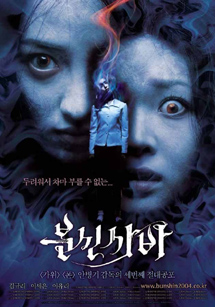 If someone were to hand me a paper and pencil (and a wad of cash) and say that I can choose any recent movie I want to remake, I think it would be Bunshinsaba. That is because, while there is a lot to like with this film, it is far from perfect and needs fleshing out. Even though the movie is a full two hours, I thought it would have benefited from more time. As it was, even at two hours, the story felt rushed and the cuts were quite sudden jumping from one scene to the next without transition. One part that needs more attention is the village itself. The cloistered and superstitious atmosphere of the village and its residents is key to this film, and yet 80 percent of the film is spent set in the girls’ high school and its grounds and 15 percent more is spent in the house of the psychic/hypnotist leaving very little time for the rest of the village. I’ll have more to say about that in a minute. First a brief summary (skip the next paragraph if you are afraid of spoilers..)
If someone were to hand me a paper and pencil (and a wad of cash) and say that I can choose any recent movie I want to remake, I think it would be Bunshinsaba. That is because, while there is a lot to like with this film, it is far from perfect and needs fleshing out. Even though the movie is a full two hours, I thought it would have benefited from more time. As it was, even at two hours, the story felt rushed and the cuts were quite sudden jumping from one scene to the next without transition. One part that needs more attention is the village itself. The cloistered and superstitious atmosphere of the village and its residents is key to this film, and yet 80 percent of the film is spent set in the girls’ high school and its grounds and 15 percent more is spent in the house of the psychic/hypnotist leaving very little time for the rest of the village. I’ll have more to say about that in a minute. First a brief summary (skip the next paragraph if you are afraid of spoilers..)
The movie begins with a trio of girls preparing a seance, chanting ‘Bunshinsaba,” a chant which is used in high schools and young soldiers to someone wandering spirits. The ring leader of the group warns the others not to open their eyes during the seance as it invites the ghost into their bodies. So, of course, someone opens their eyes… The girl’s knew the dangers going into this as they had talked about the cursed seat in their classroom which they chose as the site of their seance and they plan to put this curse on a group of four bullies who have been harrassing them, so they had strong suspicions that the ghost they were calling, long rumored to haunt their school, was an evil spirit. There curse seems to work as the next day one of the bullies is discovered burned to death in the classroom early the next morning. From there, the ghost goes on a murderous rampage, not stopping when the girls on the death list are all dispatched, but continuing on with a quest for revenge of its own. What is the revenge for? What is the dark secret the little village, where outsiders rarely visit and no one leaves? And what dark connection does the ghost have with the new Art teacher?
I started out this review by mentioning that there is a lot to like in this film. One of the things are some creative visuals. Oh, there are quite a few cliches that anyone can see coming a mile a way, but some are very well done. I especially liked the ghost(s) in the mirror scene which, in hindsight, gives some of the first clues of what is going on. I liked the fact that no one in the film simply dismissed the claims of students to have seen a ghost as they all had reason to believe it could exist. And I liked the fact that there were still revelations coming that made sense (at least in the ground rules set by the film).
What needs fixing, more than anything else, is that editing and the lack of transitions. Characters jump from scene to scene in completely different locations. Often they don’t show the emotions that one would expect based on the prior scene andit is a little jolting. I imagine that if the necessary transitions were put in, the running time would increase by half and hour, but that would not be a problem. There are other things that could be cut. For example, we don’t need to see the death of every single victim of the haunting and the psychic scenes, used to provide flashbacks, could have been greatly reduced.
Actually, in my remake, the pretty young psychic would have been replaced with a more traditional shaman. The village is supposed to be steeped in superstition and fear hence everyone believing in ghosts and curses, so the modern young psychic with the beaded curtains on the doors of her very modern house seems out of place. More time really has to be spent on the village and its dark history given the events of the film. We are not even given any shots on the community to make an estimate about how big it is.. but given the size of the girls high school, I think it is quite large ..more like a small town..which doesn’t match the atmosphere the film is attempting to create. They also needed to highlight the differences between outsiders more than they did. Even though the characters presumably no who is an outsider from generations living together, we are not given any clues until one of the characters makes a point to tell us. In the remake in my head, this differentiation would not be done through dialect, but in how the characters carry themselves..their posture and their body language.
Bunshinsaba is an interesting film that goes for shock-style scares rather than a build up of suspense. In some cases, that would annoy me, but here it is tolerated because the story was not bad. This movie is worth your time if you can track it down.. just don’t expect anything too groundbreaking. Just enjoy it for what it is..and image afterwards like I did what it could be with a good re-working of some of the elements.
7th July 2012
This is going to be an expensive week for me. There are two items being released.. one is the film, Nameless Gangster and the other is a box set entitled Historical Films about the Korean Empire. The films included in the box set are movies, not documentaries, all from 1959 and 1960. While these will probably not appeal to everyone, Iwill be purchasing it for my collection. The details on the box set are below:
Historical FIlms About the Korean Empire. Number of discs: 4/ Subtitles: Korean and English/ Rating: for ages 12+/ Format: 4:3 full screen/ Audio: Dolby Digital Mono/ Suggested Retail Price: 44,000 KRW/ Available from July 10th. The films included in this set are Kim Gojong and Martyr Ahn Jung-geun (1959) directed by Jeon Chang-geun; 110 minutes// Blood Bamboo (1959) directed by Yoon Bong-choon and Nam Hong-il; 104 minutes// The Independence Association and Lee Seung-man (1959) directed by Shin Sang-ok; 133 minutes// Ah! BaekBeom Kim Gu (1960) directed by Jeon Chang-geun, 144 minutes.
Nameless Gangster, starring Ha Jeong-woo and Choi Min-shik and directed by Yoon Jong-bin. Number of discs: 2/ Subtitles: Korean and English/ Format: 2.35:1 anamorphic widescreen/ Audio: Dolby Digital 5.1/ Suggested Retail Price: 23,100 KRW/ Available from July 11th.
Posted in DVDs: New Releases | 4 Comments »
5th July 2012
Director Kim Gi was a popular director of melodramas throughout the 1960s and 70s (although he does have one horror film in the films pictured below) and he continued making films well into the 1980s. In the years between 1970 and 1979, Kim Gi made more than 2 dozen films. I had previously posted the information for most of these and here now are the final eleven. I should note that although Because You’re a Woman was released in 1980, its production year is listed as 1979 so it is included here. You can click the thumbnail below to view a full-sized plate and you can view the plates with posters and information on Kim’s and other director’s films by clicking the tab at the top of the page marked ‘the 1970s.’
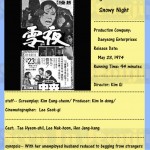 ,
, 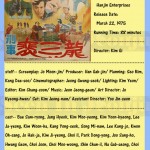 ,
, 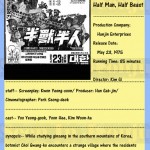 ,
, 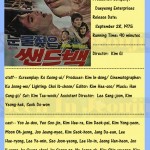 ,
, 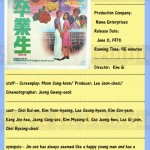 ,
, 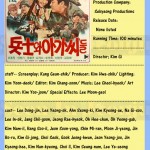 ,
, 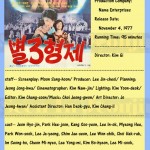 ,
, 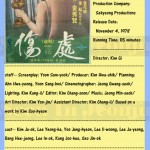 ,
, 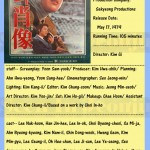 ,
,  ,
, 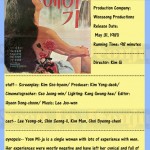 Next in the index: Kim Hyeon-yong and Kim Hyeong-joon
Next in the index: Kim Hyeon-yong and Kim Hyeong-joon
Posted in K-Movie Index | Comments Off